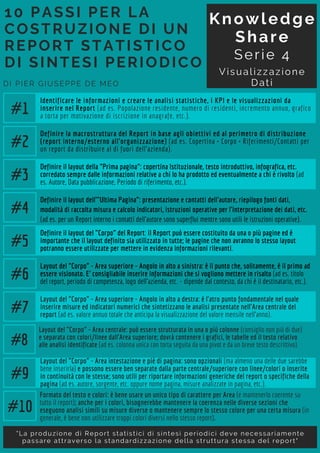
10 passi per la costruzione di un report statistico di sintesi periodico
- 1. 10 PASSI PER LA COSTRUZIONE DI UN REPORT STATISTICO DI SINTESI PERIODICO DI PIER GIUSEPPE DE MEO #1 Identificare le informazioni e creare le analisi statistiche, i KPI e le visualizzazioni da inserire nel Report (ad es. Popolazione residente, numero di residenti, incremento annuo, grafico a torta per motivazione di iscrizione in anagrafe, etc.). Knowledge Share Serie 4 Visualizzazione Dati "La produzione di Report statistici di sintesi periodici deve necessariamente passare attraverso la standardizzazione della struttura stessa del report" #2 Definire la macrostruttura del Report in base agli obiettivi ed al perimetro di distribuzione (report interno/esterno all'organizzazione) (ad es. Copertina + Corpo + Riferimenti/Contatti per un report da distribuire al di fuori dell'azienda). #3 Definire il layout della "Prima pagina": copertina Istituzionale, testo introduttivo, infografica, etc. corredato sempre dalle informazioni relative a chi lo ha prodotto ed eventualmente a chi è rivolto (ad es. Autore, Data pubblicazione, Periodo di riferimento, etc.). #4 Definire il layout dell'"Ultima Pagina": presentazione e contatti dell'autore, riepilogo fonti dati, modalità di raccolta misura e calcolo indicatori, istruzioni operative per l'interpretazione dei dati, etc. (ad es. per un Report interno i contatti dell'autore sono superflui mentre sono utili le istruzioni operative). #5 Definire il layout del "Corpo" del Report: il Report può essere costituito da una o più pagine ed è importante che il layout definito sia utilizzato in tutte; le pagine che non avranno lo stesso layout potranno essere utilizzate per mettere in evidenza informazioni rilevanti. #6 Layout del "Corpo" - Area superiore - Angolo in alto a sinistra: è il punto che, solitamente, è il primo ad essere visionato. E' consigliabile inserire informazioni che si vogliono mettere in risalto (ad es. titolo del report, periodo di competenza, logo dell'azienda, etc. - dipende dal contesto, da chi è il destinatario, etc.). #7 Layout del "Corpo" - Area superiore - Angolo in alto a destra: è l'atro punto fondamentale nel quale inserire misure ed indicatori numerici che sintetizzano le analisi presentate nell'Area centrale del report (ad es. valore annuo totale che anticipa la visualizzazione del valore mensile nell'anno). #9 Layout del "Corpo" - Area intestazione e piè di pagina: sono opzionali (ma almeno una delle due sarebbe bene inserirla) e possono essere ben separate dalla parte centrale/superiore con linee/colori o inserite in continuità con le stesse; sono utili per riportare informazioni generiche del report o specifiche della pagina (ad es. autore, sorgente, etc. oppure nome pagina, misure analizzate in pagina, etc.). #10 Formato del testo e colori: è bene usare un unico tipo di carattere per Area (e mantenerlo coerente su tutto il report); anche per i colori, bisognerebbe mantenere la coerenza nelle diverse sezioni che eseguono analisi simili su misure diverse o mantenere sempre lo stesso colore per una certa misura (in generale, è bene non utilizzare troppi colori diversi nello stesso report). #8 Layout del "Corpo" - Area centrale: può essere strutturata in una o più colonne (consiglio non più di due) e separata con colori/linee dall'Area superiore; dovrà contenere i grafici, le tabelle ed il testo relativo alle analisi identificate (ad es. colonna unica con torta seguita da una pivot e da un breve testo descrittivo).
